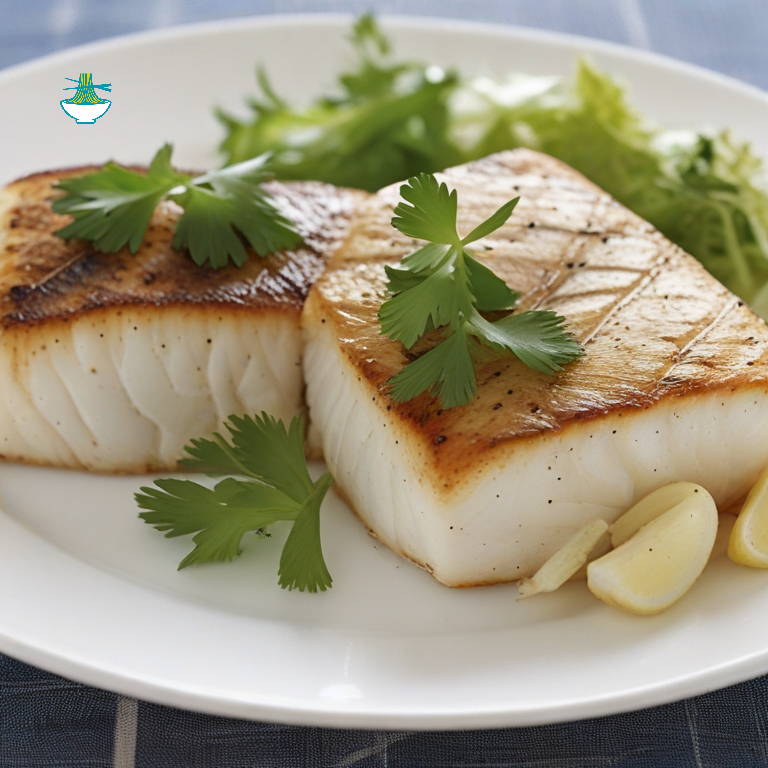Discover the allure of the Greenland Halibut, a prized species inhabiting the icy depths of Arctic waters. Also known as Reinhardtius hippoglossoides, this remarkable flatfish boasts a delicate flavor and firm texture, making it a favorite among seafood connoisseurs worldwide. Journey into the frigid seas where these elusive giants roam, and explore the unique characteristics that distinguish them from other halibut species. From their distinctive appearance to their role in sustaining Arctic ecosystems, uncover the fascinating story behind the Greenland Halibut and its significance in the culinary and ecological realms.
Ingredients:
- 4 Greenland Halibut fillets (6-8 ounces each)
- 2 tablespoons olive oil
- Salt and freshly ground black pepper, to taste
- 1 lemon, thinly sliced
For the Lemon Herb Butter:
- 1/2 cup (1 stick) unsalted butter, softened
- 2 tablespoons fresh parsley, finely chopped
- 2 tablespoons fresh dill, finely chopped
- 1 clove garlic, minced
- Zest of 1 lemon
- Salt and freshly ground black pepper, to taste

Instructions:
1- Preheat your grill to medium-high heat or preheat your oven to 400°F (200°C).
2- Prepare the Lemon Herb Butter: In a small bowl, combine the softened butter, chopped parsley, chopped dill, minced garlic, lemon zest, salt, and pepper. Mix well until all the ingredients are fully incorporated. Set aside.
3- Pat the Greenland Halibut fillets dry with paper towels. Brush both sides of the fillets with olive oil and season with salt and pepper.
4- If grilling: Place the halibut fillets directly on the preheated grill. Cook for about 4-5 minutes on each side, or until the fish is opaque and easily flakes with a fork. Place lemon slices on top of each fillet during the last 2 minutes of cooking.
5- If baking: Place the seasoned halibut fillets on a baking sheet lined with parchment paper. Bake in the preheated oven for 12-15 minutes, or until the fish is opaque and easily flakes with a fork. Place lemon slices on top of each fillet during the last 5 minutes of baking.
6- Once the halibut is cooked through, remove it from the grill or oven. Serve the grilled Greenland Halibut immediately, topped with a dollop of Lemon Herb Butter. Optionally, garnish with additional fresh herbs and lemon wedges. Enjoy your flavorful and tender Greenland Halibut!
Nutritional Values:
Here are the approximate nutritional values for the ingredients used in the Grilled Greenland Halibut with Lemon Herb Butter recipe:
Greenland Halibut fillets (6-8 ounces each):
- Calories: 150-200 kcal
- Protein: 30-40 grams
- Fat: 1-5 grams
- Carbohydrates: 0 grams
- Fiber: 0 grams
- Cholesterol: 50-80 milligrams
- Sodium: 50-100 milligrams (varies based on seasoning)
benefits:
- Excellent source of high-quality protein, essential for muscle growth and repair.
- Rich in omega-3 fatty acids, which support heart health and reduce inflammation.
- Good source of vitamins and minerals, including vitamin D, vitamin B12, and selenium.
Olive oil (2 tablespoons):
- Calories: 240 kcal
- Protein: 0 grams
- Fat: 28 grams
- Carbohydrates: 0 grams
- Fiber: 0 grams
- Cholesterol: 0 milligrams
- Sodium: 0 milligrams
benefits:
- Provides healthy monounsaturated fats, which may help reduce the risk of heart disease.
- Contains antioxidants that protect cells from damage caused by free radicals.
- May have anti-inflammatory properties and support brain health.
Lemon (1):
- Calories: 17 kcal
- Protein: 0.6 grams
- Fat: 0.2 grams
- Carbohydrates: 5.4 grams
- Fiber: 1.6 grams
- Cholesterol: 0 milligrams
- Sodium: 1 milligram
benefits:
- Rich in vitamin C, an antioxidant that boosts the immune system and promotes skin health.
- Contains flavonoids, which have antioxidant and anti-inflammatory effects.
- May aid digestion and promote hydration when consumed in water.
Unsalted butter (1/2 cup or 1 stick):
- Calories: 800 kcal
- Protein: 0.8 grams
- Fat: 92 grams
- Carbohydrates: 0.1 grams
- Fiber: 0 grams
- Cholesterol: 244 milligrams
- Sodium: 8 milligrams
benefits:
- Source of fat-soluble vitamins like vitamin A, important for vision and immune function.
- Provides energy and supports hormone production in the body.
- Contains butyrate, a type of fatty acid that may benefit digestive health.
Fresh parsley (2 tablespoons):
- Calories: 1 kcal
- Protein: 0.1 grams
- Fat: 0 grams
- Carbohydrates: 0.2 grams
- Fiber: 0.1 grams
- Cholesterol: 0 milligrams
- Sodium: 1 milligram
benefits:
- Rich in vitamin K, which is important for blood clotting and bone health.
- Contains antioxidants, including flavonoids and carotenoids, that protect against oxidative stress.
- May have antibacterial properties and support kidney health.
Fresh dill (2 tablespoons):
- Calories: 0 kcal
- Protein: 0 grams
- Fat: 0 grams
- Carbohydrates: 0 grams
- Fiber: 0 grams
- Cholesterol: 0 milligrams
- Sodium: 0 milligrams
benefits:
- Contains essential oils like eugenol and limonene, which have antioxidant and antimicrobial properties.
- Source of vitamin A, which supports eye health and immune function.
- May help alleviate digestive issues like bloating and gas.
Garlic (1 clove):
- Calories: 4 kcal
- Protein: 0.2 grams
- Fat: 0 grams
- Carbohydrates: 1 gram
- Fiber: 0.1 grams
- Cholesterol: 0 milligrams
- Sodium: 1 milligram
benefits:
- Contains allicin, a compound with antibacterial and antiviral properties.
- Rich in sulfur compounds that may help lower blood pressure and improve cholesterol levels.
- May boost immune function and reduce the risk of certain cancers.
Nutritional values may vary slightly depending on factors such as brand, specific cuts of ingredients, and cooking methods.


Comments